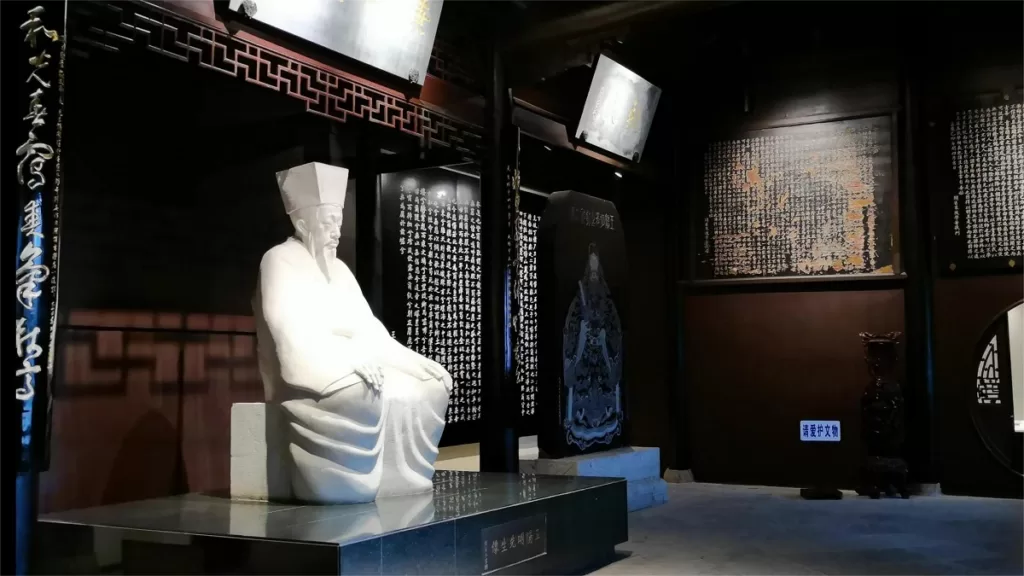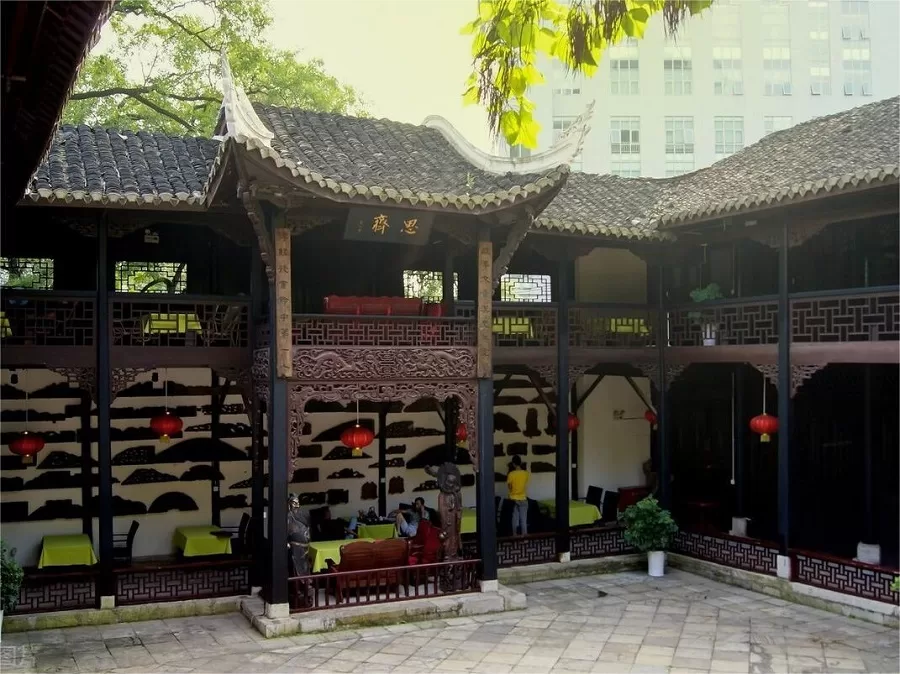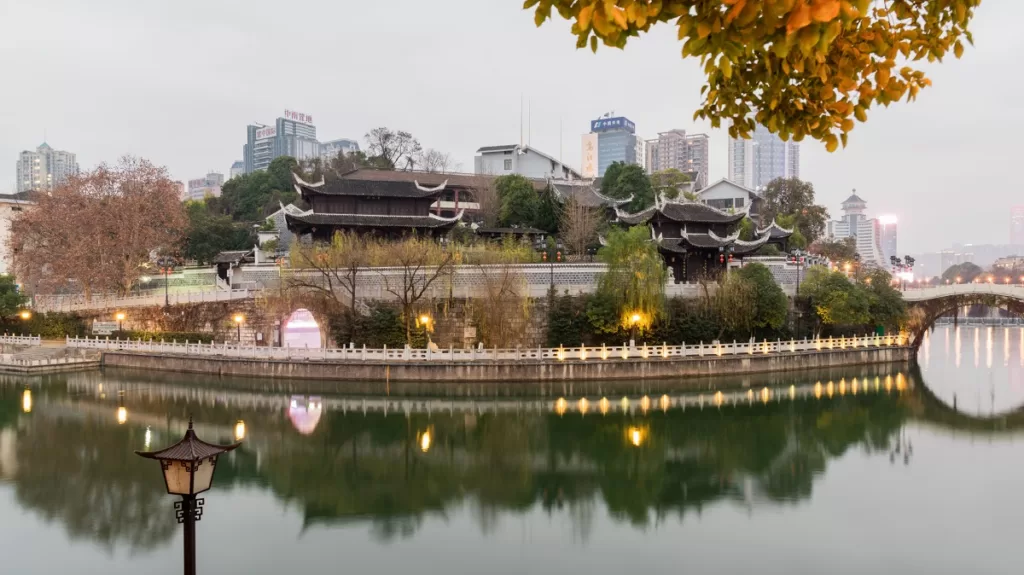贵阳阳明禅寺 - 门票、开放时间、位置和亮点


Yangming Temple (阳明祠, Yangming Shrine) is situated on the eastern side of Guiyang City and has a rich history, dating back to the 19th year of the Qing Dynasty’s Jiaqing era (1814). Comprising three distinct architectural elements – Yangming Temple, Yindaozhen Shrine, and Fufeng Temple – it collectively forms the scenic area of Fufeng Mountain.
Built in commemoration of the renowned Ming Dynasty philosopher, military strategist, and literary figure Wang Yangming (1472–1528), Yangming Temple stands as a shrine dedicated to the founder of Neo-Confucianism. The temple’s lush surroundings feature dense forests, intricately carved root sculptures, and diverse bonsai arrangements, creating a serene and picturesque atmosphere. Fragrant osmanthus trees perfume the air, while numerous inscriptions and stone tablets contribute to the cultural richness of the site. The winding corridors and tranquil pathways make for an idyllic and pleasant environment.
Beyond its role as a memorial for Wang Yangming, Yangming Temple is also a favored destination for tea enthusiasts. During a quiet afternoon, visitors can find solace in the temple’s tea house, sipping tea amid the peaceful surroundings and enjoying a leisurely escape from the bustle of daily life.
目录
基本信息
| 预计游览时间 | 1 - 2 小时 |
| 票价 | 免费 |
| 开放时间 | 9.00 - 17.00;最后入场时间:16.30 周一关闭 |
| 电话号码 | 0086-0851-85621173 0086-,0851-5261821 |
地点和交通
Yangming Temple is situated at the foothills of Fufeng Mountain, to the east of Guiyang City. Its precise location is at 13 Luosishan Road, Yunyan District, Guiyang, Guizhou Province.要到达那里,您可以选择以下方式之一:
Bus: Take bus 6, 11, 32, 36, 83, 238, 302, or 307 and get off at Yangmingci Stop (阳明祠站).
Metro: The closest metro station to Yangming Temple is Yangmingci (阳明祠) on line 2. After getting out of the station from Exit A, walk about 200 meters to the east to reach the temple.
Highlights of Yangming Temple
Yangming Temple

Yangming Temple boasts a picturesque landscape adorned with ancient Ming and Qing architectural marvels amidst towering ancient cypresses, century-old ginkgo trees, fragrant osmanthus, and verdant bamboo. At the heart of the temple lies the Wang Yangming Memorial Hall, honoring the Ming Dynasty philosopher and educator with a serene hall housing his white marble seated statue. The temple is also a repository for renowned poets’ works, calligraphy, valuable couplets, inscriptions, and historical artifacts, drawing countless visitors from around the world.
As visitors stroll through the corridors and courtyards, they encounter a variety of rare flowers and exquisite bonsai. The surrounding gardens and green spaces, equipped with stone tables and benches, offer a tranquil haven for leisure and relaxation. The rustic architecture and graceful environment resemble a serene painting, inviting contemplation and fostering a sense of profound tranquility.
Fufeng Temple

Fufeng Temple, among the three structures, holds the distinction of being the earliest constructed. In the winter of the 59th year of the Qianlong reign (1794), Wang Zhan’en, the magistrate of Guizhou, alongside locals He Mi and Zhai Xiangshi, expanded the existing Qingshu Pavilion to establish Fufeng Temple. The stone inscriptions of Wang Zhan’en’s “Zizhong Ji” and “Xizige” by He Mi stand in the temple’s courtyard. Additionally, a stone tablet commemorating the ban on stone quarrying, erected during the 21st year of the Qianlong reign by the Governor of Guizhou Ding Chang, is also present. Despite its reconstruction and expansion, the buildings were not used for Buddhist purposes but rather served as a center for the veneration of texts.
Yindaozhen Shrine

Adjacent to Fufeng Temple stands the Yindaozhen Shrine, occupying the former site of the Baoshen Shrine. In 1916, the Yindaozhen Shrine was erected on the ruins of the Baoshen Shrine. Fashioned as a quadrangle courtyard, the shrine’s moon palace-style gate leads into the hall, where a white marble seated statue of Yindaozhen rests atop a table with bamboo scrolls. On the side, one finds historical records of Yindaozhen extracted from “The History of the Later Han” and “The Records of Huayang” by contemporary Guizhou calligraphers Wang Ehua and Xie Xiaosi.
Vlog about Yangming Temple
Attractions near Yangming Temple

Huaguoyuan Wetland Park

Hebin Park (Riverside Park)

Former Site of Dade School

Zhucheng Square

Guiyang Grand Theater

Jiaxiu Pavilion

Cuiwei Garden

Wenchang Pavilion, Guiyang

Guizhou Nationalities Museum